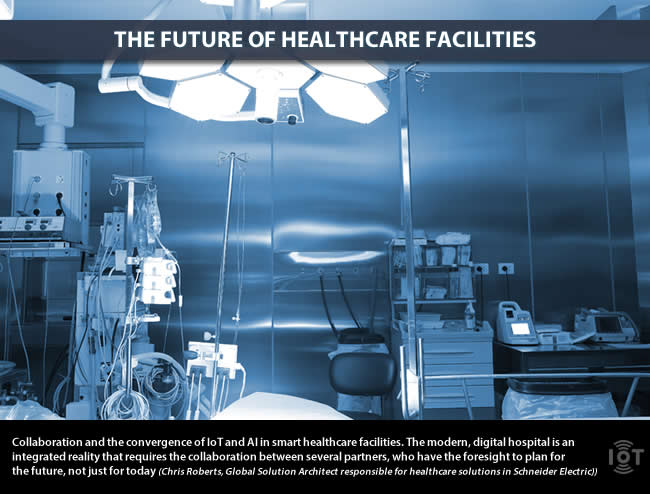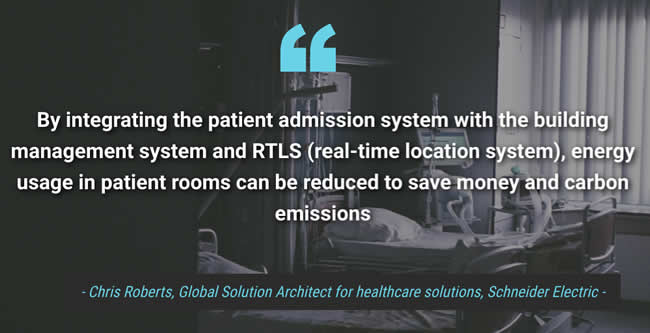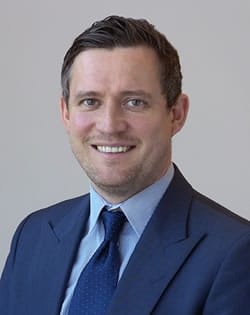Healthcare facilities are complex ecosystems with multiple challenges and stakeholders. A look at how healthcare facilities evolve and depend on collaboration and a mix of emerging tech with a key role for the Internet of Things and artificial intelligence.
The healthcare industry is a highly regulated environment with a complex ecosystem of different building types, services, systems and stakeholders. With the digital revolution in place, we must ask ourselves how this will impact the way patient care is delivered. Leveraging data for greater insights into patient care and the facility condition can have a far-reaching patient impact.
The ability to get the right information to the right place and people at the right time is critical in determining the right patient treatment, but it is also critical in ensuring the safe and appropriate operation and optimization of the facility.
It is critical we understand how data is managed and used to enable collaboration between care providers as well as the daily operation of smart healthcare facilities and enterprises
Considering the wide range of healthcare services, there are many different types of facilities and departments within a facility that have different needs and challenges to address, from critical power to infection control to staff safety and patient experience. All these challenges need to be approached and addressed in a pragmatic and collaborative way, with the aim of addressing the future health system’s key priorities:
- providing the right level of access to services for the population
- delivering quality care and outcomes
- an affordable cost for both the payee and the payer

With a greater emphasis on patient outcomes, the delivery model has shifted to a more patient-centric model of care.
This new model provides healthcare services, such as outpatient, emergency, and specialist care closer to home, with locations convenient to the patient. It is critical we understand how data is managed and used to enable collaboration between care providers as well as the daily operation of smart healthcare facilities and enterprises.
Connecting the healthcare enterprise to gain a holistic view
With the demand for greater efficiencies and insights, the continuing convergence of IT and OT is needed. This convergence focuses on greater interoperability and data exchange between systems within single or multiple facilities in a larger healthcare enterprise.
Machine learning is helping to empower facility operators with knowledge about issues in critical equipment and systems
And with the addition of AI, healthcare facilities are smarter than they’ve ever been before. Data from these disperse systems and remote facilities can now be aggregated and examined. Facility operators are provided with greater insights into the operations of each building, allowing evidence-based decisions and forecasted, predictable patterns.
This is the core of our IoT-enabled digital hospital architecture, EcoStruxure for Healthcare. By converging IoT and AI, we are able to bring the right information to the right person, anytime, anywhere to help healthcare facilities of all sizes improve patient satisfaction, operational efficiency, and safety for all. We bring all the data back to our edge platform where it gets aggregated, analyzed and presented in a meaningful manner to the operator with visualization, alarming, control, monitoring, and reporting.
The critical role of AI in moving to proactive maintenance
The role and capabilities of IoT are further enhanced in this environment thanks to AI.
Machine learning is helping to empower facility operators with knowledge about issues in critical equipment and systems. This allows the facility operator to move away from reactive maintenance to a more conditions-based and proactive maintenance approach.
IoT improves operational efficiency by focusing on reducing the burden of administrative work and improving clinical workflows for clinical staff so they can spend more time with the patients
By moving to this conditions-based approach, digital hospitals will be able to plan and schedule maintenance work based on priority, leading to increased efficiency and reduced risk of unplanned outages and downtime that could result in delayed patient care.
Healthcare facility managers are continually battling to control the backlog maintenance issues and keep the facility in a good condition. With data-driven insights and recommendations, they now have guidance for where to focus first.
Collaboration is key in achieving facility intelligence
Our IoT-enabled digital hospital architecture EcoStruxure for Healthcare enables healthcare facility managers to achieve the operational efficiency, patient satisfaction, and patient safety by gaining visibility into how the building is operating. However, the key to leveraging AI and IoT in healthcare facilities is in collaboration.
The modern, digital hospital is an integrated reality that requires the collaboration between several partners, who have the foresight to plan for the future, not just for today
With many stakeholders and systems in place, it is common to have competing goals. Without shared goals, AI and IoT loses its value. Collaboration starts with healthcare executives, clinical providers, IT and facilities all being on the same page. But in the case of new build or major retrofits, it should also include the design teams, contractors and technology providers, where a broader view of experience and best practices can be applied. Teamwork is essential in achieving optimal facility intelligence.
Last but certainly not least, it requires teamwork and collaboration with our core EcoXpert partners who execute and optimize the healthcare facility projects. EcoXperts are critical in terms of how we can be more agile in deploying solutions to our healthcare customers.
EcoXpert partners who are certified in Critical Power or in BMS can follow an EcoXpert specialization for healthcare. In the EcoXpert partner program healthcare specialization, we educate our partners, share best practices globally, look at the latest technologies, provide insight on the latest trends and challenges in the healthcare market. We also share case studies and repeatable solution architectures for building digital hospitals.
The goal is not just to help our EcoXperts to become knowledgeable and trusted partners of healthcare facility decision makers, but first and foremost to enable them to build the solutions that offer the most value to the many stakeholders in the healthcare ecosystem.

Strong partnerships for the future of smart healthcare facilities and healthcare quality
In terms of what the future holds for the use of IoT and AI in healthcare facilities, there are likely to be several evolutions that focus on use cases to solve very specific challenges.
For example, IoT improves operational efficiency by focusing on reducing the burden of administrative work and improving clinical workflows for clinical staff so they can spend more time with the patients. Asset location services are an example of this. Instead of having to walk around a ward looking for a heart rate monitor or other medical equipment, the real-time location system (RTLS) can quickly identify and locate the nearest machine.
Space optimization uses IoT to provide greater insight into how the facility is used or underused, thus allowing decisions to be made on the design, reconfiguration of spaces and facilities based on the needs all stakeholders.
Autonomous guided vehicles further reduce the burden of staff by delivering catering, linen and drugs across large facilities, they also help to reduce the potential for infection and cross contamination.
Technologies are enabling clinicians to take the best decisions faster than ever for their patients and it is also allowing facility operators to make more informed decisions on how they deliver facility maintenance to ensure a safe and comfortable environment for the occupants. .
However, as more equipment is being used and healthcare facilities are already very energy-intensive, energy remains one of the big areas where facility operators focus on.
When you look at energy inside the healthcare facility, the question is how to optimize energy usage and save energy based on how the facility is been used. You can achieve that through various means including energy sourcing programs, energy conservation measures, use of micro-grids, and with facility intelligence.
Space optimization uses IoT to provide greater insight into how the facility is used or underused, thus allowing decisions to be made on the design, reconfiguration of spaces and facilities
For example, by integrating the patient admission system with the building management system and RTLS, energy usage in patient rooms can be reduced to save money and carbon emissions. For energy-intensive and critical environments such as operating theaters, connecting to the surgery scheduling systems will allow for greater optimization of how systems such as ventilation are working.
This view on energy consumption, energy sourcing and energy usage further drives the market and connects all types of energy, from water, air, gas and steam to electricity.
The modern, digital hospital is an integrated reality that requires the collaboration between several partners, who have the foresight to plan for the future, not just for today.
I would invite building management and certainly critical power experts to take a deeper dive into the EcoXpert healthcare specialization to learn more about how we can leverage IoT and AI to improve healthcare overall.
About the author: Chris Roberts
Chris Roberts is the Global Solution Architect responsible for healthcare solutions in Schneider Electric.

With over 15 years’ experience in the healthcare market Chris is responsible for the ideation, design, development, and support of intelligent healthcare infrastructure solutions. Working directly with customers and strategic partners Chris develops architectures that aim to improve both operational efficiency, patient safety and patient experience for healthcare systems around the world.
Prior to his current role, Chris, worked in the design and construction of several major healthcare projects in the UK including Durham’s Dryburn Hospital, Edinburgh RVI, Royal Shrewsbury and Manchester University Hospital
Mr. Roberts also sits on the board of Directors for the IFMA Health Care Institute and contributes to the American Society for Healthcare Engineers (ASHE), the Healthcare Information and Management Systems Society (HIMSS), and the Institution of Engineering and Technology (MIET).
Disclosure: this is a sponsored post in the scope of the commercial collaboration between i-SCOOP and Schneider Electric, containing links to solutions and the business partner program of Schneider Electric.
More on healthcare facilities and evolutions
- Building a thriving global healthcare facility expert community: interview
- Global health challenges with Paul Stoffels (Johnson & Johnson)
- The digital twin in hospitals – a strategic partnership for the smart hospital
- Wouter De Ploey (CEO of hospital network ZNA): transformation in the hospital sector
- Frank Dendas (Philips): new healthcare models have become a necessity

